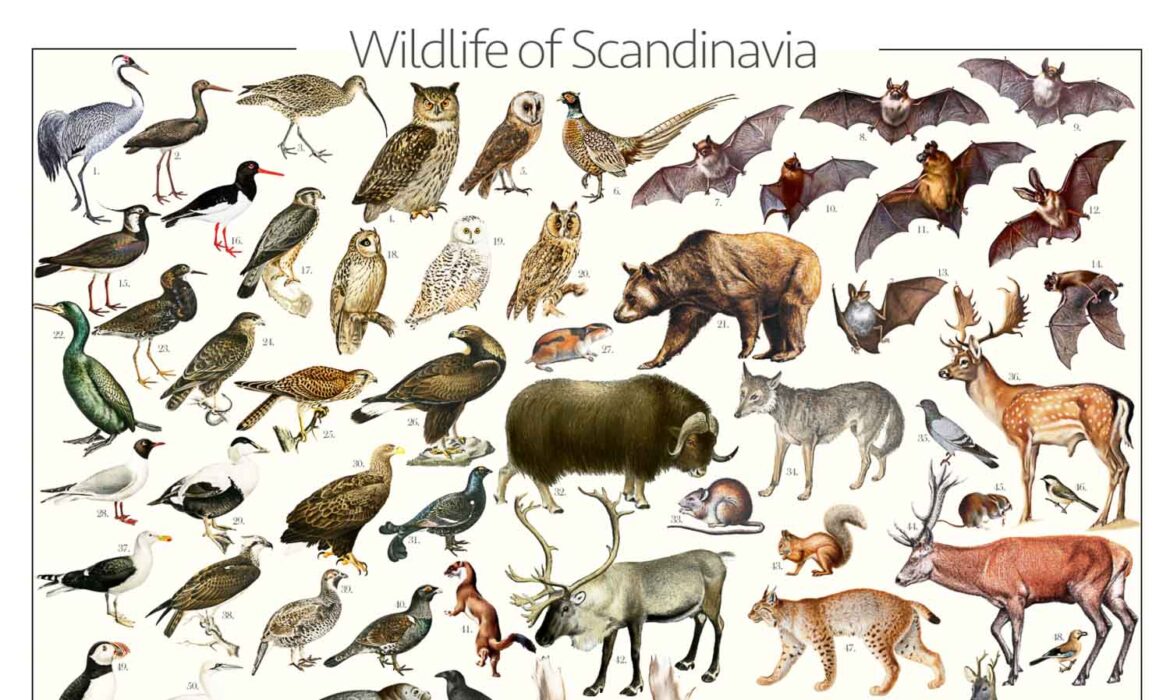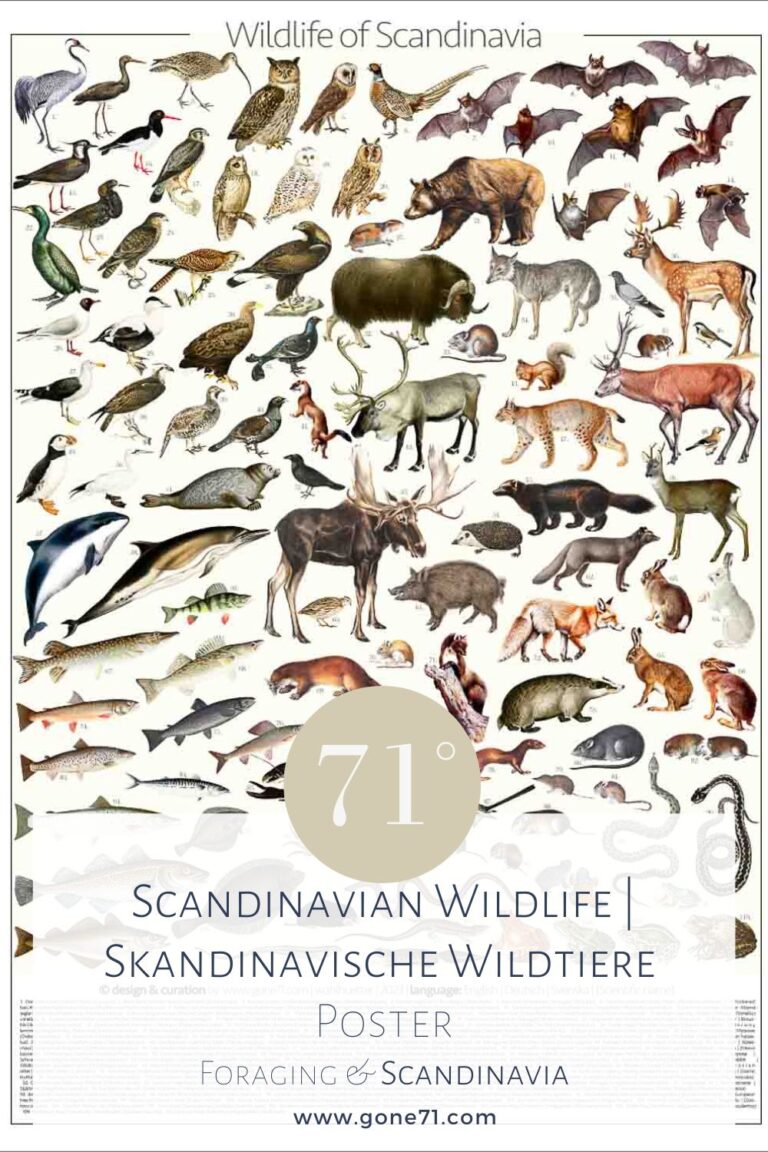This meticulously crafted poster is a true testament to the diversity and beauty of Scandinavian wildlife, showcasing some of the most important and captivating species from humble frogs to the majestic brown bear. Languages: English | Deutsch | Svenska
Every detail of this poster has been crafted with high standard, including extensive research that has gone into identifying relevant species of Scandinavian wildlife. Whether you are a wildlife enthusiast, a nature lover, or simply appreciate the beauty of the natural world, this poster is sure to captivate and inspire.
As you explore the intricate illustrations and learn about the various species, you will be transported on a journey through the fascinating and diverse world of Scandinavian wildlife. This poster is the perfect addition to any home, classroom, or office and is sure to be treasured for years to come.
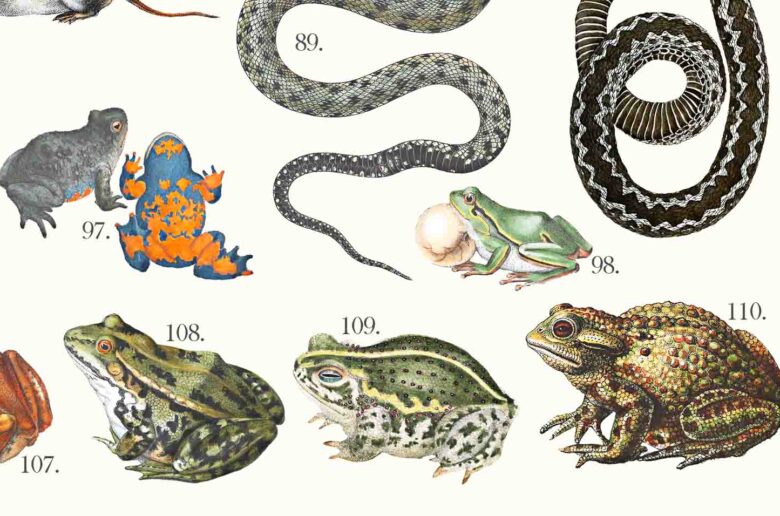
About this Scandinavian wildlife poster
This poster features 110 species of Scandinavian vertebrats, each meticulously researched and depicted in detail. The animals are named in four languages: English, Deutsch, Svenska and Scientific name, making it a valuable resource for nature enthusiasts and educators alike.
The poster boasts a very high resolution, ensuring that every intricate detail of each animal is captured in vivid clarity. Sized at DIN A1, it’s large enough to easily view each animal and appreciate its unique characteristics. Whether you’re a seasoned naturalist or just beginning to explore the fascinating world of Scandinavian wildlife, this poster is an aestethicaly pleasing addition.
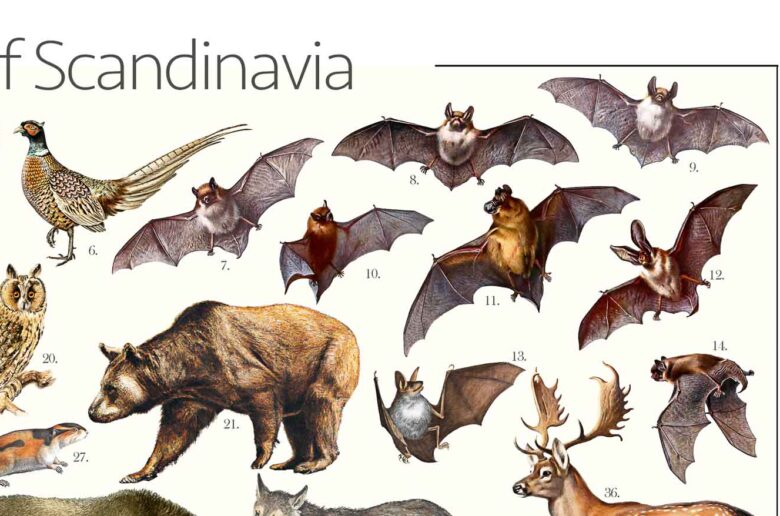
About Scandinavian wildlife
Scandinavia is home to a vast array of vertebrates, each one perfectly adapted to survive in the harsh and unforgiving climates of the north. From the elusive lynx to the majestic elk, the wildlife of Scandinavia represents a diverse and wondrous tapestry of life.
What makes the Scandinavian wildlife so captivating is not only its sheer beauty but also its tenacity and resilience in the face of adversity. Many of these animals have had to evolve special adaptations to survive the harsh and unpredictable nature of the north. For example, the arctic fox has adapted to its environment by developing a realtive small size, keen senses, and the ability to survive in extreme cold climates, while the reindeer has evolved to survive on a diet of lichens and other tough vegetation.
In addition to the larger and more well-known species, such as the brown bear and moose, the Scandinavian wilderness is also home to a diverse array of smaller animals. These include the Northern crested newt, that can be found near bodies of water, as well as various species of frogs, lizards, snakes, bats, and rodents. Despite their small size, these animals play an important role in the ecosystem, and contribute to the overall biodiversity of the region.
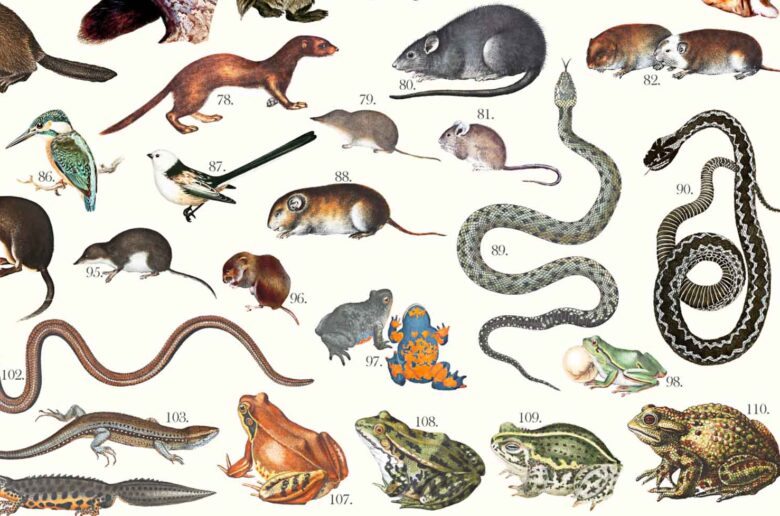
List of featured animals pt. 1
1. Common crane | Kranich | Trana | (Grus grus)
2. Black stork | Schwarz Storch | Svart stork | (Ciconia nigra)
3. Eurasian curlew | Großer Brachvogel | Storspov | (Numenius arquata)
4. Eurasian eagle-owl | Uhu | Berguv | (Bubo bubo)
5. Barn owl | Schleiereule | Tornuggla | (Tyto alba)
6. Common pheasant | Fasan | Fasan | (Phasianus colchicus)
7. Whiskered bat | Kleine Bartfledermaus | Mustaschfladdermus (Myotis mystacinus)
8. Natter’s bat | Fransenfledermaus | Fransfladdermusen | (Myotis nattereri)
9. Bechstein’s bat | Bechsteinfledermaus | Bechsteins fladdermus (Myotis bechsteinii)
10. Common pipistrelle | Zwergfledermaus | Sydpipistrell | (Pipistrellus pipistrellus)
11. Common noctule | Großer Abendsegler | Större brunfladdermus | (Nyctalus noctula)
12. Brown long-eared bat | Braunes Langohr | Brunlångöra | (Plecotus auritus)
13. Parti-coloured bat | Zweifarbfledermaus | Gråskimlig fladdermus | (Vespertilio murinus)
14. Daubenton’s bat | Wasserfledermaus | Vattenfladdermus | (Myotis daubentonii)
15. Northern lapwing | Kiebitz | Tofsvipa | (Vanellus vanellus)
16. Eurasian oystercatcher | Austernfischer | Strandskata | (Haematopus ostralegus)
17. Merlin | Merlin | Stenfalk | (Falco columbarius)
18. Short-eared owl | Sumpfohreule | Jorduggla | (Asio flammeus)
19. Snowy owl | Schnee-Eule | Fjälluggla | (Bubo scandiacus)
20. Long-eared owl | Waldohreule | Hornuggla | (Asio otus)
21. Brown bear | Braunbär | Brunbjörn | (Ursus arctos)
22. Great cormorant | Kormoran | Storskarv | (Phalacrocorax carbo)
23. Ruf | Kampfläufer | Brushane (Calidris pugnax)
24. Common buzzard | Mäusebussard | Ormvråk | (Buteo buteo)
25. Common kestrel | Turmfalke | Tornfalk | (Falco tinnunculus)
26. Golden eagle | Steinadler | Kungsörn | (Aquila chrysaetos)
27. Norway lemming | Berglemming | Fjällämmel | (Lemmus lemmus)
28. Black-headed gull | Lachmöwe | Skrattmås | (Chroicocephalus ridibundus)
29. Common eider | Edierenden | Ejder | (Somateria mollissima)
30. White-tailed eagle | Seeadler | Havsörn | (Haliaeetus albicilla)
31. Black grouse | Birkhuhn | Orre | (Lyrurus tetrix)
32. Muskox | Moschusochse | Myskoxe (Ovibos moschatus)
33. Brown rat | Wanderratte | Brunråtta | (Rattus norvegicus)
34. Wolf | Wolf | Varg | (Canis lupus)
35. Rock dove | Felsentaube | Klippduva | (Columba livia)
36. Fallow deer | Damhirsch | Dovhjort | (Dama dama)
37. Great black-backed gull | Mantelmöwe | Havstrut | (Larus marinus)
38. Osprey | Fischadler | Fiskgjuse | (Pandion haliaetus)
39. Hazel grouse | Haselhuhn | Järpe | (Tetrastes bonasia)
40. Wood grouse | Auerhuhn | Tjäder | (Tetrao urogallus)
41. Stoat | Hermelin | Hermelin | (Mustela erminea)
42. Reindeer | Rentier | Ren | (Rangifer tarandus)
43. Red squirrel | Eichhörnchen | Ekorre | (Sciurus vulgaris)
44. Red deer | Rothirsch | Kronhjort | (Cervus elaphus)
45. Bank vole | Rötelmaus | Långsvansad skogssork | (Clethrionomys glareolus)
46. Grey-headed chickadee | Lapplandmeise | Lappmes | (Poecile cinctus)
47. Lynx | Luchs | Lodjur | (Lynx lynx)
48. Eurasian jay | Eichelhäher | Nötskrika | (Garrulus glandarius)
49. Atlantic puffin | Papageitaucher | Lunnefågel | (Fratercula arctica)
50. Northern gannet | Basstölpel | Havssula | (Morus bassanus)
51. Harbor seal | Seehund | Knubbsäl (Phoca vitulina)
52. Common raven | Kolkrabe | Korp (Corvus corax)
53. Moose | Elch | Europeisk älg | (Alces alces)
54. European hedgehog | Braunbrustigel | Igelkott | (Erinaceus europaeus)
55. Wolverine | Vielfraß | Järv | (Gulo gulo)
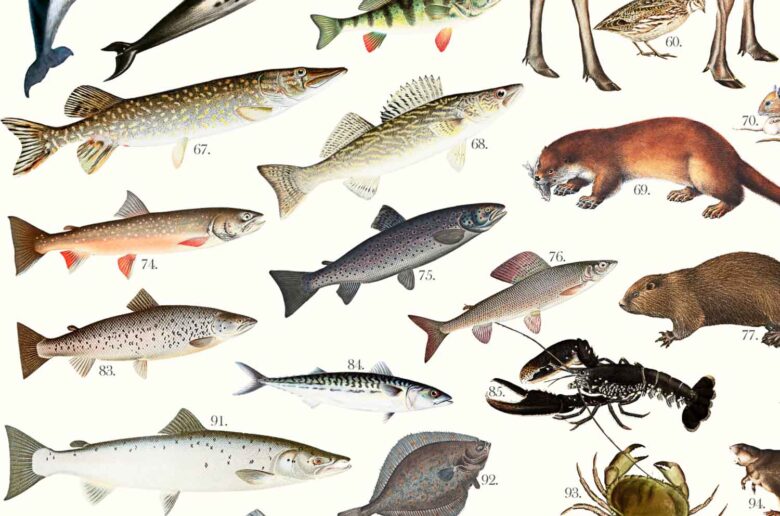
List of featured animals pt. 2
56. Roe deer | Reh | Rådjur | (Capreolus capreolus)
57. Harbour porpoise | Schweinswal | Vanlig Tumlare | (Phocoena phocoena)
58. Common dolphin | Gemeiner Delfin | Sadeldelfin | (Delphinus delphis)
59. Perch | Flussbarsch | Abborre | (Perca fluviatilis)
60. Common quail | Wachtel | Vaktel | (Coturnix coturnix)
61. Wild boar | Wildschwein | Vildsvin | (Sus scrofa)
62. Arctic fox | Polarfuchs | Fjällräv | (Vulpes lagopus)
63. Rabbit | Wildkaninchen | Europeisk kanin | (Oryctolagus cuniculus)
64. Mountain hare | Schneehase | Skogshare | (Lepus timidus) (Winter)
65. European hare | Feldhase | Fälthare | (Lepus europaeus)
66. Mountain hare | Schneehase | Skogshare | (Lepus timidus)
67. Pike | Hecht | Gödde | (Esox lucius)
68. Pike perch | Zander | Gös | (Sander lucioperca)
69. Eurasian otter | Fischotter | Utter | (Lutra lutra)
70. Wood mouse | Waldmaus | Mindre skogsmusen | (Apodemus sylvaticus)
71. Pine marten | Baummader | Mård | (Martes martes)
72. Red fox | Rotfuchs | Vänlig räv | (Vulpes vulpes)
73. Bagger | Dachs | Grävling | (Meles meles)
74. Arctic Char | Saibling | Röding | (Savelinus alpinus)
75. Trout | Forelle | Öring | (Salmo trutta)
76. Grayling | Äsche | Harr | (Thymallus thymallus)
77. Eurasian beaver | Bieber | Europeisk bäver | (Castor fiber)
78. Least wesel | Mauswiesel | Vessla | (Mustela nivalis)
79. Common shrew | Waldspitzmaus | Vanlig näbbmus | (Sorex araneus)
80. Black rat | Hausratte | Svartråtta | (Rattus rattus)
81. House mouse | Hausmaus | Husmus | (Mus musculus)
82. Common vole | Feldmaus | Fältsork | (Microtus arvalis)
83. Seatrout | Meerforelle | Havsöring | (Salmo trutta trutta)
84. Atlantic mackerel | Makrele (Scomber scombrus)
85. European lobster | Hummer | Europeisk hummer | (Homarus gammarus)
86. Common kingfisher | Eisvogel | Kungsfiskare | (Alcedo atthis)
87. Long-tailed tit | Schwanzmeise | Stjärtmes | (Aegithalos caudatus)
88. European water voll | Große Wühlmaus | Vattensork | (Arvicola amphibius)
89. Grass snake | Ringelnatter | Snok | (Natrix natrix)
90. European adder | Kreuzotter | Huggorm | (Vipera berus)
91. Atlantic salmon | Atlantischer Lachs | Lax | (Salmo salar)
92. European plaice | Scholle | Rödspätta | (Pleuronectes platessa)
93. Brown crab | Taschenkrebs | Krabbtaska | (Cancer pagurus)
94. Muskrat | Bisamratte | Bisam | (Ondatra zibethicus)
95. Eurasian water shrew | Wasserspitzmaus | Vattennäbbmus | (Neomys fodiens)
96. Short-tailed field vole | Erdmaus | Åkersork | (Microtus agrestis)
97. Fire bellied toad | Rotbauchunke | Klockgrodan | (Bombina bombina)
98. European tree frog | Laubfrosch | Lövgroda | (Hyla arborea)
99. Atlantic cod | Dorsch | Torsk | (Gadus morhua)
100. Atlantic halibut | Heilbutt | Hälleflundra | (Hippoglossus hippoglossus)
101. European mole | Maulwurf | Mullvad | (Talpa europaea)
102. low worm | Blindschleiche | Kopparödla | (Anguis fragilis)
103. Common lizard | Waldeidechse | Skogsödla | (Zootoca vivipara)
104. Coal fish | Köhler | Sej | (Pollachius virens)
105. Sand lizard | Zauneidechse | Sandödla | (Lacerta agilis)
106. Northern crested newt | Nördlicher Kammmolch | Större vattensalamandern | (Triturus cristatus)
107. Common frog | Grasfrosch | Vanlig groda | (Rana temporaria)
108. Edible frog | Teichfrosch | Ätlig groda | (Pelophylax kl. esculentus)
109. Natterjack toad | Kreuzkröte | Strandpadda | (Epidalea calamita)
110. Common toad | Erdkröte | Vanliga paddan | (Bufo bufo)
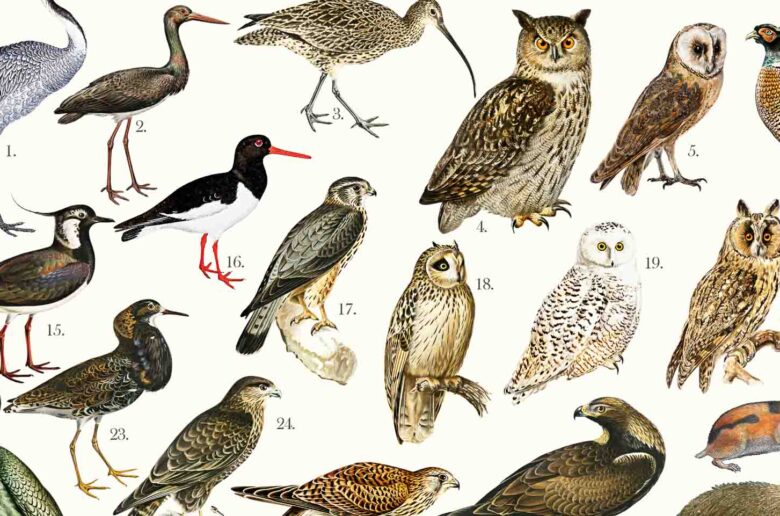
“Digital foraging”
This Scandinavian wildlife poster is part of our “digital foraging series”, which aims to explore and uncover the vast and untapped world of digital information.
Personally, I perceive the pursuit of historical depictions of marine life, fungi, birds, wild fruits or other related subjects as digital foraging, entailing extensive searches across scientific databases and centuries-old records.
With an almost limitless array of historic images and resources available online, the possibilities for creative and informative works of art are nearly endless. This wildlife poster is a stunning example of what can be achieved through digital foraging, combining detailed illustrations and accurate scientific information to create a beautiful and educational work of art.
Unfortunately it takes much more than just a quick search to get the results you see here. It takes days of research, technical know-how and a keen eye to find the right images, in the right resolution, and format. And that’s just the beginning. The real work starts with processing, restoring and manipulating the images to create something new and unique. So make no mistake, there are serious hours invested in such an endeavor.

